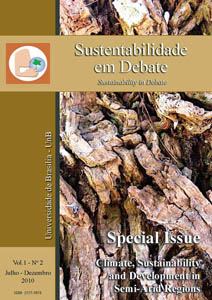Individual Land Tenure and the Challenges of Sustainable Land Use and Management in a Semi-arid Region of China
DOI:
https://doi.org/10.18472/SustDeb.v1n2.2010.1683Palabras clave:
Land tenure, Poverty, Environment, Governance, InstitutionsResumen
China’s farmland tenure, characterised by a household responsibility system (HRS) and collective landownership, has contributed to the continuation of poverty and natural resource deterioration in semiarid regions. Incongruent with local ecological, social and political conditions, the HRS has been linked to rising social and political tensions. Drawing on ethnographic research in Guyuan County, North China, this paper provides peasants’ experiences of and views on the land issue and examines the linkages between land tenure, poverty and the governance of natural resources””grassland, forest land, farmland and water. It shows that an appropriate land tenure system can only be achieved if the fragmentation and individualization of the HRS are reformed through an innovative institutional design. The paper also contributes to a critical understanding of China’s agrarian reform by articulating the need for land tenure diversity serving the overall goal of sustainable land use and management and shaping sound statepeasant relations.
Descargas
Citas
wancheng quansheng jiti linquan zhidu gaige
renwu: zai quansheng jiti linquan zhidu gaige
diaodu huiyi shang de jianghua (Sticking to the
target and overcoming difficulties to ensure
the completion of the tasks of provincial
collective forestry reform: Speech at the provincial
collective forestry reform coordination
meeting), unpublished speech note, 2007.
BANKS, T. et al. Community-based grassland
management in western China: rationale, pilot
experience, and policy implications. Mountain
Research and Development, v. 23, n. 2, p. 132-
140, 2003.
BRAMALL, C. Chinese land reform in long-term
perspective and in the wider East Asian context.
Journal of Agrarian Change, v. 4, n. 1 and 2,
p. 107-141, 2004.
CAI, Y. Collective ownership or cadres’
ownership? The non-agricultural use of farmland
in China. The China Quarterly, issue 175, p.
662-680, 2003.
CHANG, K.S. The social-political processes of
agricultural decollectivisation in a North China
commune. China Report, 30 (4), p. 395-406,
1994.
CHIN, T. Securing a rural land market: politicaleconomic
determinants of institutional change in
China’s agricultural sector. Asian Perspective,
v. 29, n. 4, p. 209-244, 2005.
CHRISTIANSEN, F.; Zhang, J. (eds) Village
INC.: Chinese rural society in the 1990s.
Honolulu: University of Hawai’i Press, 1998.
CUI, H.; Wang, L. Tuigenghuanlin gongcheng
yu nongcun shehui yunxing: jiyu hebaisheng
guyuanxian de shizheng fenxi (Green for grain
programme and rural society: empirical studies
on Guyuan county. Proceedings of China Social
Science Annual Conference, 2006.
DIETZ, T. et al. The struggle to govern the
commons. Science, 302, p. 1907-1912, 2003.
FOUCAULT, M. Disciplinary power and
subjection. Steven Lukes (ed) Power. New York:
New York University Press, 1986.
Government of China Grassland Law of the
People’s Republic of China. Beijing: Ministry
of Agriculture, 2002
Government of China Rural Land Contracting
Law of the People’s Republic of China. Beijing:
Ministry of Agriculture, 2002.
Government of China Zhonggong zhongyang
guowuyuan guanyu tuijin jiti linquan gaige de
yijian (Communist Party Central Committee State
Council opinion on promoting collective forestry
tenure reform). http://english.gov.cn/jrzg/2008-
07/14/content_1044403.htm, 2008, accessed on
20 December 2009.
GUPTA, A. Postcolonial Developments:
agriculture in the making of the modern India.
Durham, NC: Duke University Press, 1998.
Guyuan County Government Guyuan Xianzhi (Guyuan County history). Baoding: Zhongguo
sanxia Press, 2003.
Guyuan Poverty Alleviation Office Guyu Fupin
Kaifa Gongzuo Qingkuang de Diaoyan Baogao
(Research report on poverty and development in
Guyuan County), unpublished report, 2007.
HARDIN, G. Tragedy of the commons. Science
162, p. 1243, 1968.
HINTON, W. The Privatization of China: the
Great Reversal. London: Earthscan Publications,
1990.
HO, P. Developmental Dilemmas: land reform
and institutional change in China. London & New
York: Routledge, 2005.
HU, W. Household land tenure reform in China:
its impact on farming land use and agroenvironment.
Land Use Policy, v. 14, n. 3, p.
175-186, 1997.
HUANG, Y. Agricultural Reform in China.
Cambridge: Cambridge University Press, 1998.
JIANG, H. Decentralization, ecological
construction, and the environment in post-reform
China: case study from Uxin Banner, Inner
Mongolia. World Development, v. 34, n. 11, p.
1907-1921, 2006.
KAHRL, F. et al New horizons for rural reform
in China: resources, property rights and
consumerism. Stanford Centre for International
Development, http://are.berkeley.edu/~dwrh/
Slides/SCID_KRHZ_100105.pdf, 2005,
accessed on 15 January 2010.
KUNG, J. et al Rural cadres and governance in
China: incentive, institution and accountability.
The China Journal, n. 62, p. 61-77, 2009.
LAI, L. W. C. Land use rights reform and the
real estate market in China: a synoptic account
of theoretical issues and the property rights
system. Property Management, v. 13, n. 4, p.
21-28, 1995.
LI, X. et al. (eds) Environment and Poverty:
the Chinese practice and international
experiences. Beijing: Social Sciences Academic
Press (China), 2005.
LI, X. et al. (eds.) 2003-2004 Status of Rural
China. Beijing: Social Sciences Academic Press
(China), 2004.
LICHTENBERG, E.; Ding, C. Assessing
farmland protection policy in China. Land Use
Policy, 25, p. 59-68, 2008.
LIEBERTHAL, G.; Lampton, M. Bureaucracy,
Politics, and Decision-Making in Post-Mao
China. Berkeley & Los Angeles: University of
California Press, 1992.
LIN, G.; & Ho, S. P. S. China’s land resources
and land-use change: insights from the 1996 land
survey. Land Use Policy, 20, p. 87-103, 2003.
MIAO, G.; West, R. A. China collective
forestlands: contributions and constraints.
International Forestry Review, v. 6 (3-4), p.
282-298, 2004.
Ministry of Agriculture Nongyebu bangongting
guanyu hebeisheng guyuanxian kaiken caoyuan
anjian chachu qingkuang de tongbao (Circular
of the Ministry of Agriculture’s decision on the
inspection and punishment concerning the
Guyuan County of Hebei Province’s
mismanagement of grassland cases), issue n. 29,
2006.
MULDAVIN, J. Environmental degradation in
Heilongjiang: policy reform and agrarian
dynamics in China’s new hybrid economy. Annals
of Association of American Geographers, 87
(4), p. 579-613, 1997.
NONINI, M. Is China becoming neoliberal? Critique
of Anthropology, v. 28 (2), p. 145-176,
2008.
SANDERS, R. The political economy of Chinese
environmental protection: lessons of the Mao and
Deng years. Third World Quarterly, 20 (6), p.
1201-1214, 1999.
SCOTT, J. C. Weapons of the Weak: everyday
forms of peasant resistance. New Haven: Yale
University Press, 1985.
SOLINGER, D. J. The floating population in the
cities: markets, migration, and the prospects for
citizenship. Susan D. Blum & Lionel M. Jensen
(eds) China Off Centre: mapping the middle
margins of the middle kingdom, p. 273-290,
Manoa: University of Hawai’i Press, 2002.
STRAUSS, J. C. Forestry reform and the
transformation of state capacity in Fin-de-Siecle
China. The Journal of Asian Studies, v. 68, n.
4, p. 1163-1188, 2009.
SZIRMAI, A. The Dynamics of Social-
Economic Development: an introduction.
Cambridge: Cambridge University Press, 2005.
WANG, S. et al. Recent land use changes in north
dust storm source area affecting Beijing and
Tianjin: agro-pastoral transitional zone. IEEE,
p. 2402-2405, 2005.
WILLIAMS, M. The barbed walls of China: a
contemporary grassland drama. The Journal of
Asian Studies, 55, 3, p. 665-691, 1996.
XINHUA NET (2006) Guyuan: feifa kaiken
caoyuan shijian de beihou (Guyuan: what is
behind the case of illegal grassland reclamation).
http://www.he.xinhuanet.com/dishi/2006-03/30/
content_6607521.htm, accessed on 13 July 2008,
2006.
Xinhua News Agency China to push forward
collective forestry land reform. http://
www.china.org.cn, 15 July 2008, accessed on 18
July 2008.
YEH, T. Property relations in Tibet since
decollectivisation and the question of fuzziness.
Conservation and Society, 2, 1, p. 107-131,
2004.
ZEN, D. Collectives’ land in countryside should
be used under taxation. Study on China’s Land
Problems. Beijing: China Economic Press, p. 78-
81, 1991.
ZHANG, L. Strangers in the City:
reconfigurations of space, power, and social
networks within China’s floating population.
Stanford: Stanford University Press, 2001.
Descargas
Publicado
Cómo citar
Número
Sección
Licencia
Derechos de autor 2010 Sustentabilidade em Debate

Esta obra está bajo una licencia internacional Creative Commons Atribución-NoComercial-SinDerivadas 4.0.
La presentación de la(s) obra(s) científica(s) original(es) por parte de los autores, como titulares de los derechos de autor de los textos enviados a la revista, de conformidad con la Ley 9.610/98, implica la cesión de derechos de autor de publicaciones impresas y/o digitales a la Revista de Sustenibilidad en Debate de los artículos aprobados para fines de publicación, en un único número de la Revista, autorizando también que la(s) obra(s) científica(s) aprobada(s) se divulguen de forma gratuita, sin ningún tipo de reembolso de derechos de autor, a través del sitio web de a Revista, para leer, imprimir y/o descargar el archivo de texto, a partir de la fecha de aceptación para publicación. Por lo tanto, los autores, al presentar los artículos a la Revista y, en consecuencia, la libre cesión de derechos de autor relacionados con el trabajo científico presentado, son plenamente conscientes de que no serán remunerados por la publicación de los artículos en la revista.Â
La Revista está licenciada bajo una licencia no comercial y sin derivaciones Creative Commons (No permite la realización de obras derivadas) 3.0 Brasil, con el propósito de difundir conocimientos científicos, como se indica en el sitio web de la publicación, que permite el intercambio del texto y el reconocimiento de su autoría y publicación original en esta revista.
Los autores pueden asumir contratos adicionales por separado, para la distribución no exclusiva de las obras publicadas en la revista Sustenibilidad en Debate (por ejemplo, en un capítulo de libro), siempre que se indique que los textos se publicaron originalmente en esta revista y que se menciona el DOI correspondiente. Se permite y incentiva a los autores a publicar y distribuir su texto online después de su publicación (por ejemplo, en repositorios institucionales o en sus páginas personales).Â
Los autores aceptan expresamente los términos de esta Declaración de Derechos de Autor, que se aplicará a la presentación si es publicada por esta Revista.






